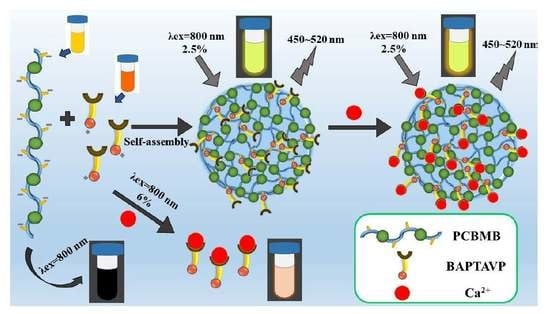Enhanced Two-Photon Fluorescence and Fluorescence Imaging of Novel Probe for Calcium Ion by Self-Assembly with Conjugated Polymer
Abstract
1. Introduction
2. Experimental
2.1. Chemicals and Instruments
2.2. Synthesis
2.2.1. Procedure for the Synthesis of 5-(4-vinyl-N-methyl pyridine iodized salt)-5′-Methyl-BAPTA Ethyl Ester (BAPTAVP)
2.2.2. Procedure for the Synthesis of 3,6-bis-(methyl ketone)-N-bromoethyl-carbazole (6)
2.2.3. Procedure for the Synthesis of the Conjugated Polymer (PCBMB)
2.3. Preparation of Solutions and Spectral Measure
2.4. General Processes for Cell Culture and Fluorescence Imaging
3. Results and Discussion
3.1. Design of BAPTAVP and PCBMB
3.2. Linear and Nonlinear Spectra of BAPTAVPwith Ca2+Titration
3.3. Dissociation Constant of BAPTAVP/Ca2+Complex
3.4. The Effects of Different Volumes of PCBMBon the Fluorescence of BAPTAVP
3.5. The Enhanced Fluorescence of Probe-Polymer System Detection of Ca2+
3.6. Fluorescence Enhanced Mechanism
3.7. Fluorescence Microscopy Imaging
4. Conclusions
Supplementary Materials
Author Contributions
Funding
Acknowledgments
Conflicts of Interest
References
- Mohan, P.S.; Lim, C.S.; Tian, Y.S.; Roh, W.Y.; Lee, J.H.; Cho, B.R. A two-photon fluorescent probe for near-membrane calcium ions in live cells and tissues. Chem. Commun. 2009, 36, 5365–5367. [Google Scholar] [CrossRef] [PubMed]
- Wu, Y.X.; Li, J.B.; Liang, L.H.; Lu, D.Q.; Zhang, J.; Mao, G.J.; Zhou, L.Y.; Zhang, X.B.; Tan, W.; Shen, G.L.; et al. A rhodamine-appended water-soluble conjugated polymer: An efficient ratiometric fluorescence sensing platform for intracellular metal-ion probing. Chem. Commun. 2014, 50, 2040–2042. [Google Scholar] [CrossRef] [PubMed]
- Liu, Z.C.; Jing, X.; Zhang, S.J.; Tian, Y. A copper nanocluster-based fluorescent probe for real-time imaging and ratiometric biosensing of calcium ions in neurons. Anal. Chem. 2019, 91, 2488–2497. [Google Scholar] [CrossRef] [PubMed]
- Berridge, M.J.; Lipp, P.; Bootman, M.D. The versatility and universality of calcium signaling. Nat. Rev. Mol. Cell. Biol. 2000, 1, 11–21. [Google Scholar] [CrossRef] [PubMed]
- Carafoli, E.; Santella, L.; Branca, D.; Brini, M. Generation, control, and processing of cellular calcium signals. Crit. Rev. Biochem. Mol. 2001, 36, 107–260. [Google Scholar] [CrossRef] [PubMed]
- Bootman, M.D.; Berridge, M.J. The elemental principles of calcium signaling. Cell 2009, 83, 675–678. [Google Scholar] [CrossRef]
- Berridge, M.J.; Bootman, M.D.; Roderick, H.L. Calcium signalling: Dynamics, homeostasis and remodeling. Nat. Rev. Mol. Cell. Biol. 2003, 4, 517–529. [Google Scholar] [CrossRef] [PubMed]
- Shin, Y.N.; Lim, C.S.; Tian, Y.S.; Rho, W.Y.; Cho, B.R. Detection of near-membrane calcium ions in live tissues with a two-photon fluorescent probe. Bull. Korean Chem. Soc. 2010, 31, 599–605. [Google Scholar] [CrossRef][Green Version]
- Eggeling, C.; Volkmer, A.; Seidel, C.A.M. Molecular photobleaching kinetics of rhodamine 6G by one- and two-photon induced confocal fluorescence microscopy. ChemPhysChem 2005, 6, 791–804. [Google Scholar] [CrossRef] [PubMed]
- Kim, D.; Moon, H.; Baik, S.H.; Singha, S. Two-photon absorbing dyes with minimal autofluorescence in tissue imaging: Application to in vivo imaging of amyloid-β plaques with a negligible background signal. J. Am. Chem. Soc. 2015, 137, 6781–6789. [Google Scholar] [CrossRef] [PubMed]
- Lim, C.S.; Kang, M.Y.; Han, J.H.; Danish, I.A.; Cho, B.R. In vivo imaging of near-membrane calcium ions with two-photon probes. Chem. Asian. J. 2011, 6, 2028–2033. [Google Scholar] [CrossRef] [PubMed]
- Tojyo, Y.; Tanimura, A.; Matsumoto, Y. Monitoring of Ca2+ release from intracellular stores in permeabilized rat parotid acinar cells using the fluorescent indicators mag-fura-2 and calcium green C18. Biochem. Biophys. Res. Commun. 1997, 240, 189–195. [Google Scholar] [CrossRef]
- Park, H.; Hoang, D.T.; Paeng, K.; Kaufman, L.J. Localizing exciton recombination sites in conformationally distinct single conjugated polymers by super-resolution fluorescence imaging. ACS Nano. 2015, 9, 3151–3158. [Google Scholar] [CrossRef] [PubMed]
- Ruan, Z.; Yuan, P.; Li, T.; Tian, Y.; Cheng, Q.; Yan, L. Glutathione triggered near infrared fluorescence imaging-guided chemotherapy by cyanine conjugated polypeptide. ACS Biomater. Sci. Eng. 2018, 4, 4208–4218. [Google Scholar] [CrossRef]
- Wu, C.; Szymanski, C.; Cain, Z.; McNeill, J. Conjugated polymer dots for multiphoton fluorescence imaging. J. Am. Chem. Soc. 2007, 129, 12904–12905. [Google Scholar] [CrossRef]
- Li, S.; Jiang, X.F.; Xu, Q.H. Conjugated polymers for two-photon live cell imaging. In Conjugated Polymers for Biological and Biomedical Applications; Liu, B.L., Ed.; Willey: Hoboken, NJ, USA, 2018; pp. 135–170. [Google Scholar]
- Wei, L.; Zhang, D.; Zheng, X.; Zeng, X.; Zeng, Y.; Shi, X.; Shu, X.; Xiao, L. Fabrication of positively charged fluorescent polymer nanoparticles for cell imaging and gene delivery. Nanotheranostics 2018, 2, 157–167. [Google Scholar] [CrossRef] [PubMed]
- Meng, X.L.; Zhang, X.; Yao, J.S.; Zhang, J.J.; Ding, B.Y. Fluorescence and fluorescence imaging of two Schiff derivatives sensitive to Fe3+ induced by single- and two-photon excitation. Sens. Actuators B Chem. 2013, 176, 488–496. [Google Scholar] [CrossRef]
- Gao, Z.Y.; Zhang, C.J.; Zhang, X.; Xing, S.; Yao, J.S.; Qiao, C.D.; Liu, W.L. A new “turn-on” fluorescence probe for Al3+ detection and application exploring in living cell and real samples. Appl. Sci. 2019, 9, 577. [Google Scholar] [CrossRef]
- Kim, H.J.; Lim, C.S.; Lee, H.W.; Lee, H.S.; Um, Y.J.; Han, I.; Kim, M.K. A ratiometric two-photon probe for Ca2+, in live tissues and its application to spinal cord injury model. Biomaterials 2017, 141, 251–259. [Google Scholar] [CrossRef]
- Zhao, X.J.; Wang, C.; Yuan, G.Q.; Ding, H.Y.; Zhou, L.Y.; Liu, X.Q. A dual-site modulated FRET-based two-photon ratiometric fluorescent probe for tracking lysosomal pH changes in living cells, tissues and zebrafish. Sens. Actuators B Chem. 2019, 290, 79–86. [Google Scholar] [CrossRef]
- Zhang, C.J.; Gao, Z.Y.; Wang, Q.B.; Zhang, X. Highly sensitive detection of melamine based on the fluorescence resonance energy transfer between conjugated polymer nanoparticles and gold nanoparticles. Polymers 2018, 10, 873. [Google Scholar] [CrossRef] [PubMed]
- Sha, J.; Song, Y.; Liu, B.X.; Lü, C.L. Host–guest-recognition-based polymer brush-functionalized mesoporous silica nanoparticles loaded with conjugated polymers: A facile FRET-based ratiometric probe for Hg2+. Micropor. Mesopor. Mater. 2015, 218, 137–143. [Google Scholar] [CrossRef]
- Grynkiewicz, G.; Poenie, M.; Tsien, Y. A new generation of Ca2+ indicators with greatly improved fluorescence properties. J. Biol. Chem. 1985, 260, 3440–3450. [Google Scholar] [PubMed]
- Zhao, C.F.; He, G.S.; Bhawalkar, J.D.; Park, C.K.; Prasad, P.N. Newly synthesized dyes and their polymer/glass composites for one- and two-photon pumped solid-state cavity lasing. Chem. Mater. 1995, 7, 1979–1983. [Google Scholar] [CrossRef]
- Zhang, X.; Sun, Y.; Yu, X.Q.; Zhang, B.Q.; Huang, B.B.; Jiang, M.H. Synthesis and nonlinear optical properties of several new two-photon photopolymerization initiators about dibenzothiophene derivatives. Syn. Met. 2009, 159, 2491–2496. [Google Scholar] [CrossRef]
- Wu, Q.Q.; Song, Q.H. Photosensitized splitting of thymine dimer or oxetane unit by a covalently N-linked carbazole via electron transfer in different Marcus regions. J. Phys. Chem. B 2010, 114, 9827–9832. [Google Scholar] [CrossRef] [PubMed]
- Danish, I.A.; Lim, C.S.; Tian, Y.S.; Han, J.H.; Kang, M.Y.; Cho, B.R. Two-photon probes for Zn2+ ions with various dissociation constants. Detection of Zn2+ ions in live cells and tissues by two-photon microscopy. Chem. Asian J. 2011, 6, 1234–1240. [Google Scholar] [CrossRef] [PubMed]
- Thomas, S.W.; Joly, G.D.; Swager, T.M. Chemical sensors based on amplifying fluorescent conjugated polymers. Chem. Rev. 2007, 107, 1339–1386. [Google Scholar] [CrossRef]
- Wang, H.; Li, Z.; Shao, P.; Qin, J.; Huang, Z.L. Two-photon absorption property of a conjugated polymer: Influence of solvent and concentration on its property. J. Phys. Chem. B 2009, 114, 22–27. [Google Scholar] [CrossRef]
- Liu, Y.; Qiao, Q.; Zhao, M.; Yin, W.; Miao, L.; Wang, L.; Xu, Z. Cd2+-triggered amide-tautomerization produces a highly Cd2+-selective fluorescent sensor across a wide pH range. Dyes Pigment. 2016, 133, 339–344. [Google Scholar] [CrossRef]
- Gao, Z.Y.; Zhang, X.; Xing, S.; Lu, Q.; Yao, J.S.; Liu, Q.Z.; Qiao, C.D.; Xie, R.X.; Ding, B.Y. Conjugated polymer nanoparticles based on carbazole for detecting ferric ion (III) with a large Stokes shift and high sensitivity and the application in cell imaging. Dyes Pigment. 2019, 168, 68–76. [Google Scholar] [CrossRef]
- Sui, B.L.; Liu, X.L.; Wang, M.Y.; Belfield, K.D. A highly selective fluorescence turn-on sensor for extracellular calcium ion detection. Chem. Eur. J. 2016, 22, 10351–10354. [Google Scholar] [CrossRef]
- Zhang, X.; Li, L.L.; Liu, Y.K. Fluorescent detection and imaging of Hg2+ using a novel phenanthroline derivative based single- and two-photon excitation. Mater. Sci. Eng. C 2016, 59, 916–923. [Google Scholar] [CrossRef] [PubMed]
- Rockwell, P.L.; Storey, B.T. Determination of the intracellular dissociation constant, K(D), of the fluo-3. Ca (2+) complex in mouse sperm for use in estimating intracellular Ca(2+) concentrations. Mol. Reprod. Dev. 1999, 54, 418–428. [Google Scholar] [CrossRef]
- Zhao, M.; Hollingworth, S.; Baylor, S.M. Properties of tri- and tetracarboxylate Ca2+indicators in frog skeletal muscle fibers. Biophys. J. 1996, 70, 896–916. [Google Scholar] [CrossRef]
- Li, S.; Shen, X.; Li, L.; Yuan, P.; Guan, Z.; Yao, S.Q.; Xu, Q.H. Conjugated-polymer-based red-emitting nanoparticles for two-photon excitation cell imaging with high contrast. Langmuir 2014, 30, 7623–7627. [Google Scholar] [CrossRef]
- Ding, D.S.; Lu, Z.H. The second harmonic component in the Bessel beam. Appl. Phys. Lett. 1996, 68, 608–610. [Google Scholar] [CrossRef]
- Matsui, P.; Sadhu, K.K.; Mizukami, S.; Kikuchi, K. Highly selective tridentate fluorescent probes for visualizing intracellular Mg2+ dynamics without interference from Ca2+fluctuation. Chem. Commun. 2017, 53, 10644–10647. [Google Scholar] [CrossRef]
- Xu, Z.; Xiao, Y.; Qian, X.; Cui, J.; Cui, D. Ratiometric and selective fluorescent sensor for Cu (II) based on internal charge transfer (ICT). Org. Lett. 2005, 7, 889–892. [Google Scholar] [CrossRef]
- Wang, J.B.; Qian, X.F.; Cui, J.N. Detecting Hg2+ ions with an ICT fluorescent sensor molecule: Remarkable emission spectra shift and unique selectivity. J. Org. Chem. 2006, 71, 4308–4311. [Google Scholar] [CrossRef]
- Li, L.L.; Zhang, X.; Zhang, W.J.; Li, W.; Sun, W.H.; Redshaw, C. Zinc 2-((2-(benzoimidazol-2-yl)quinolin-8-ylimino) methyl) phenolates: Synthesis, characterization and photoluminescence behavior. Spectrochim. Acta A Mol. Biomol. Spectrosc. 2014, 118, 1047–1055. [Google Scholar] [CrossRef]
- Chris, X.; Webb, W.W. Measurement of two-photon excitation cross sections of molecular fluorophores with data from 690 nm to 1050 nm. Opt. Soc. Am. 1996, 13, 481–491. [Google Scholar]
- Huang, F.; Tian, Y.; Chen, C.Y.; Cheng, Y.J.; Young, C.A.; Jen, A.K.Y. Cross-conjugated polymers with large two-photon absorption cross-sections for metal ion sensing. J. Phys. Chem. C 2007, 111, 10673–10681. [Google Scholar] [CrossRef]
- Hu, L.W.; Liang, L.; Yong, Y. Green-emitting polyfluorenes containing hexylthiophen-dibenzothiophene-S,S-dioxide unit with large two-photon absorption cross section. Chin. J. Polym. Sci. 2018, 36, 546–554. [Google Scholar] [CrossRef]
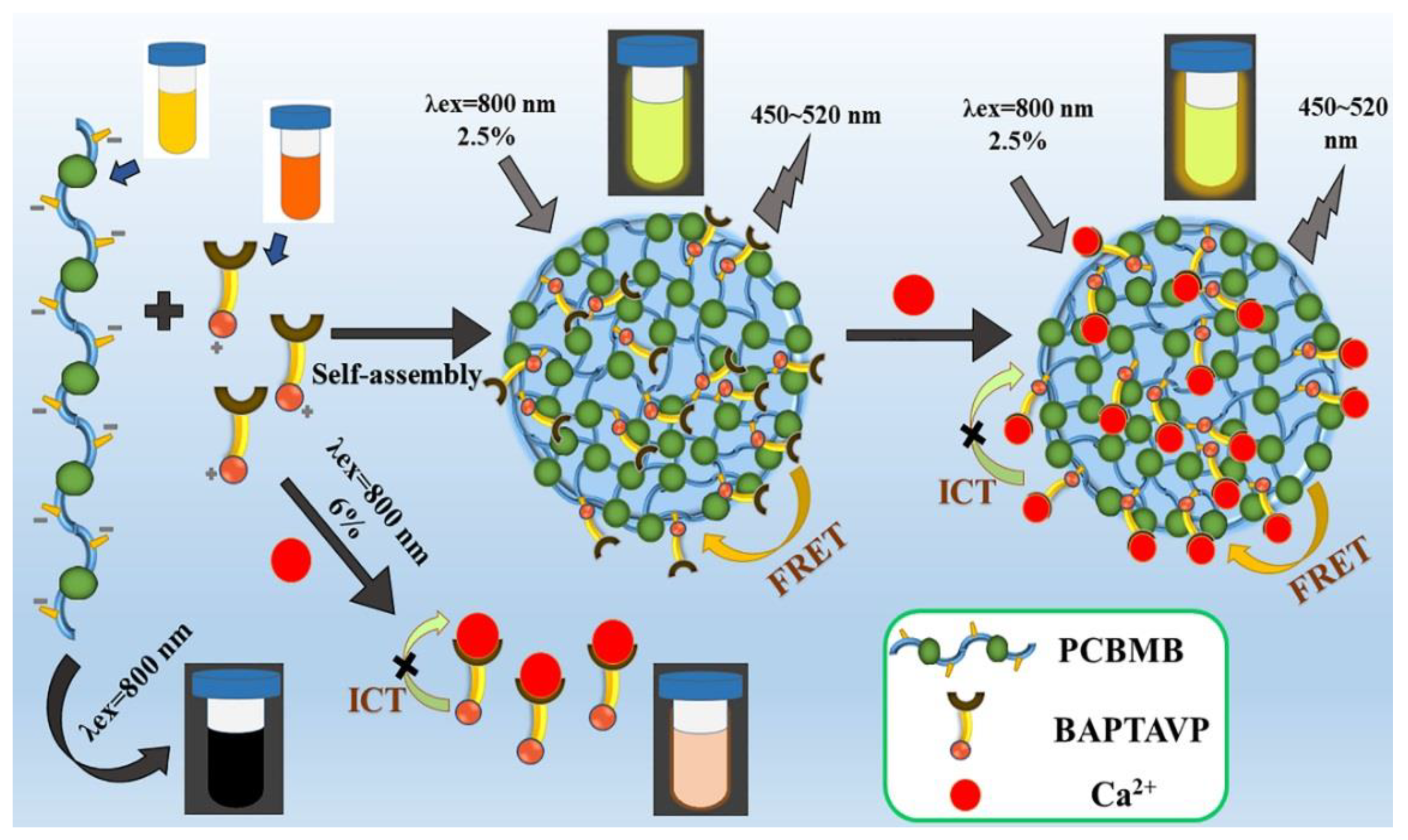
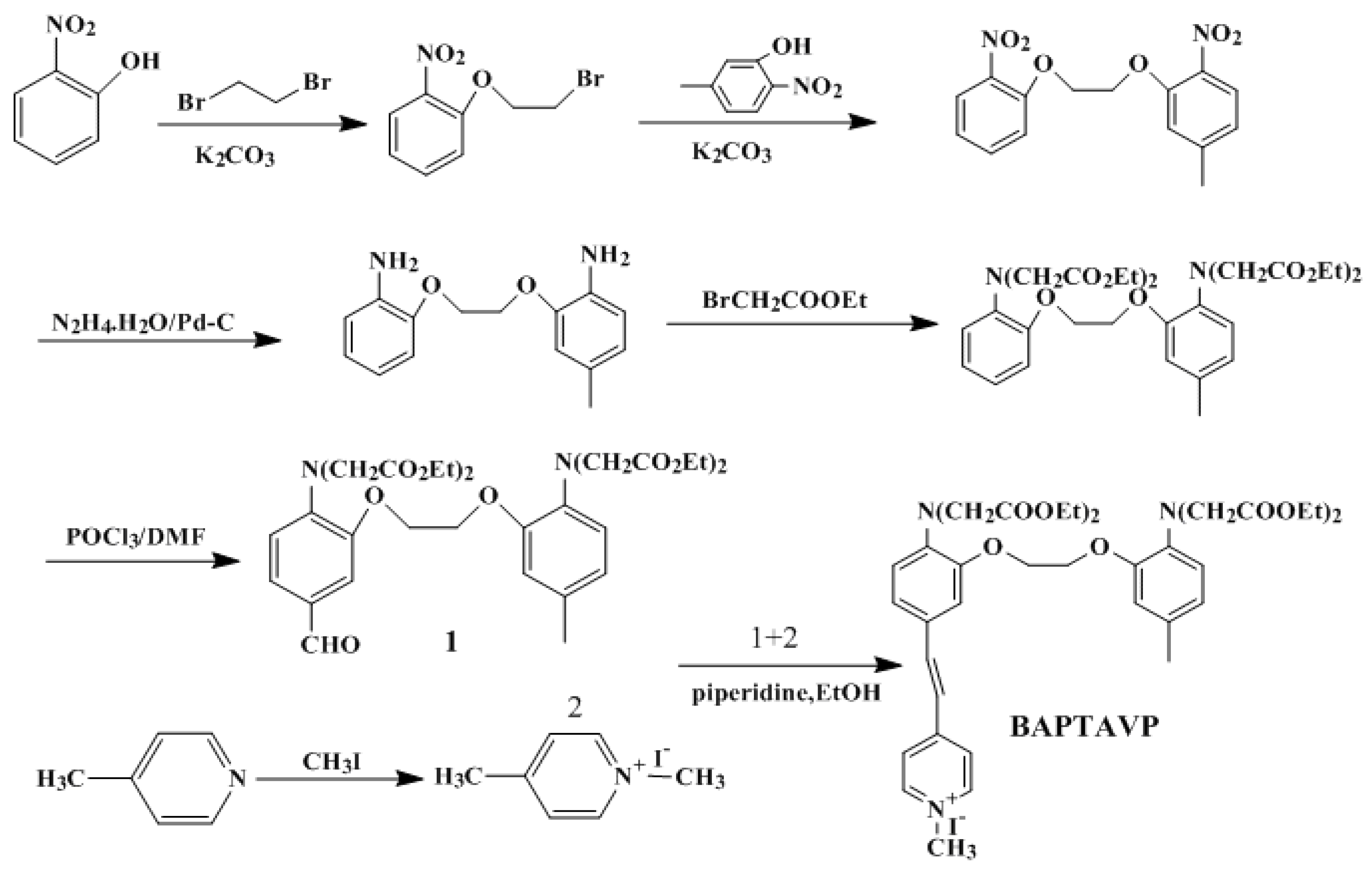
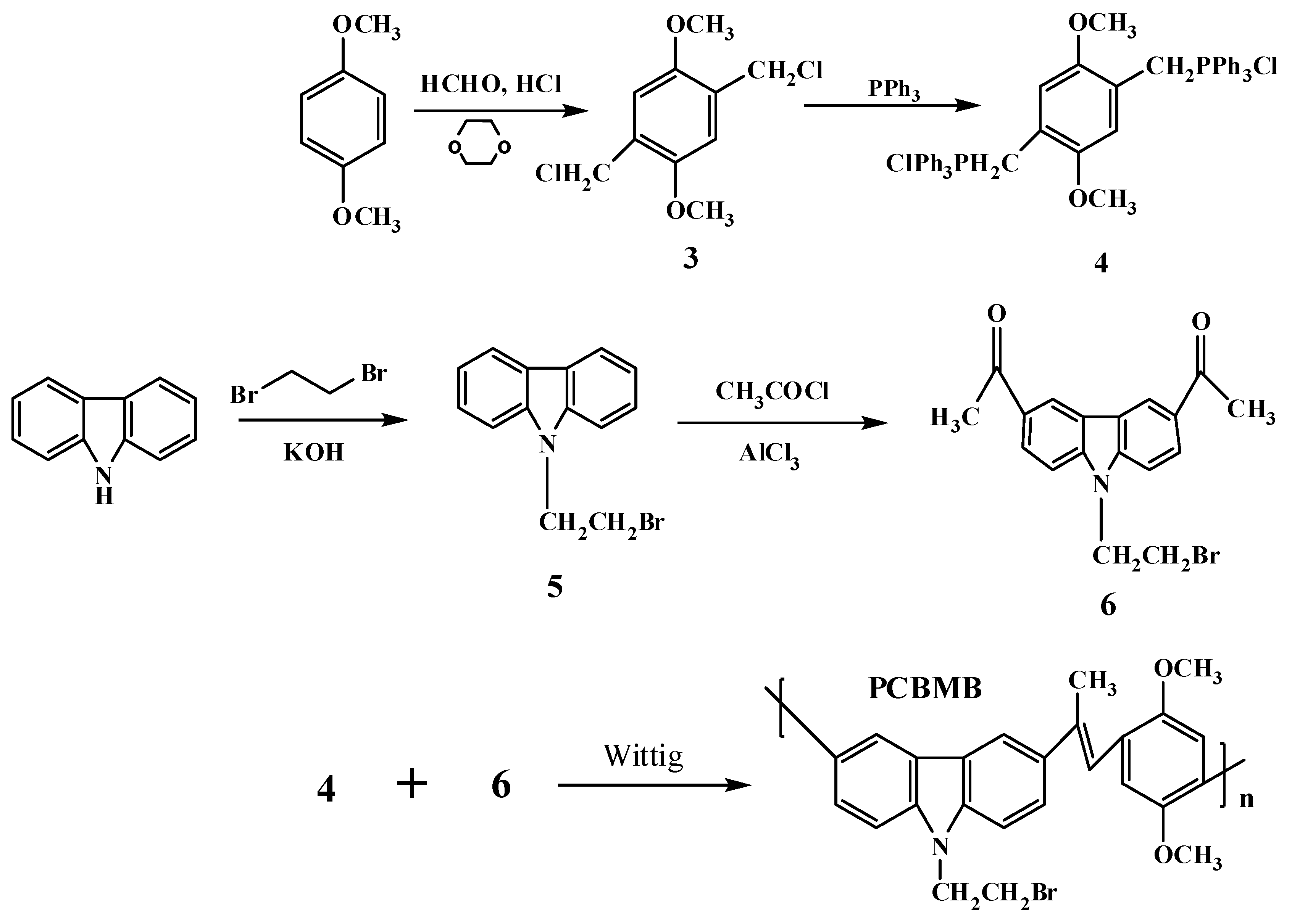
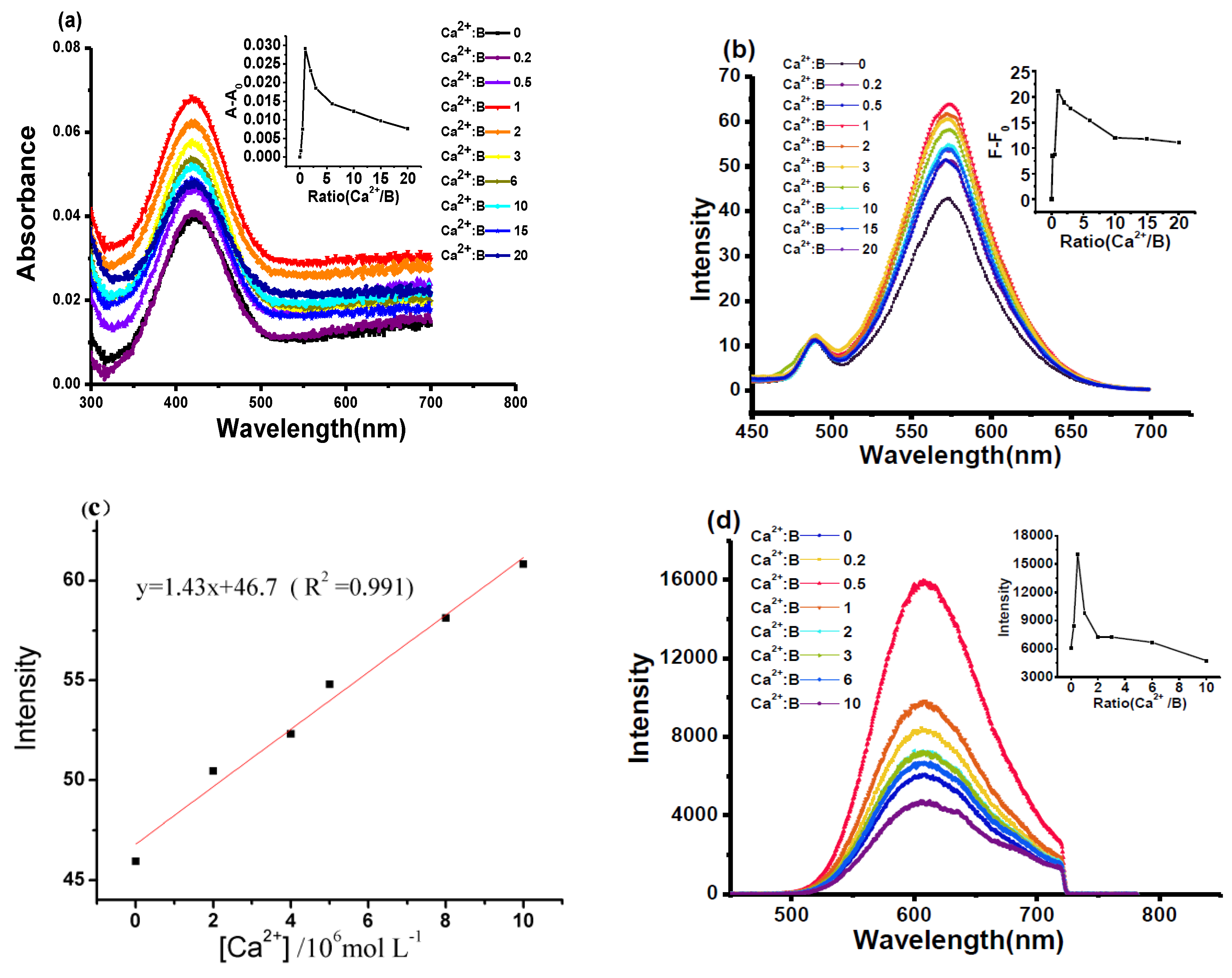
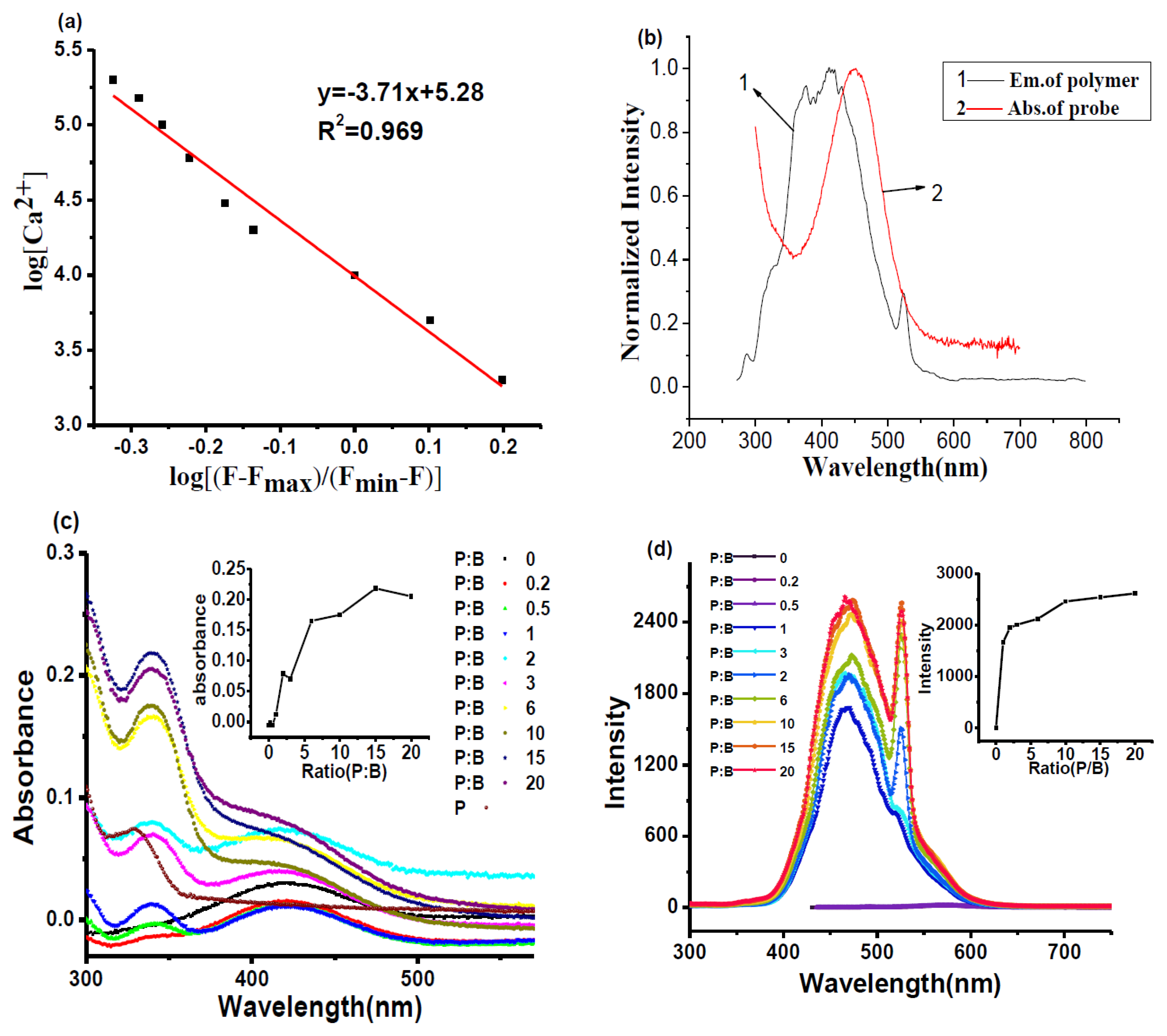
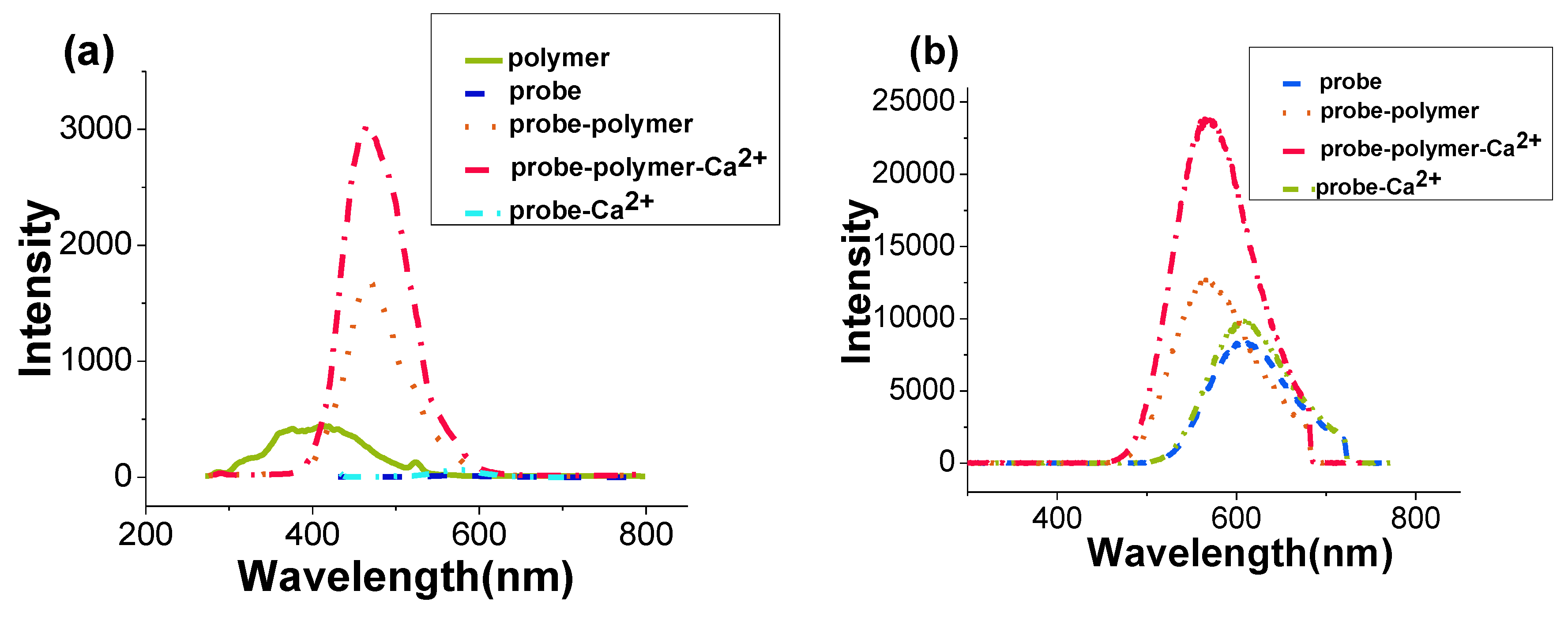
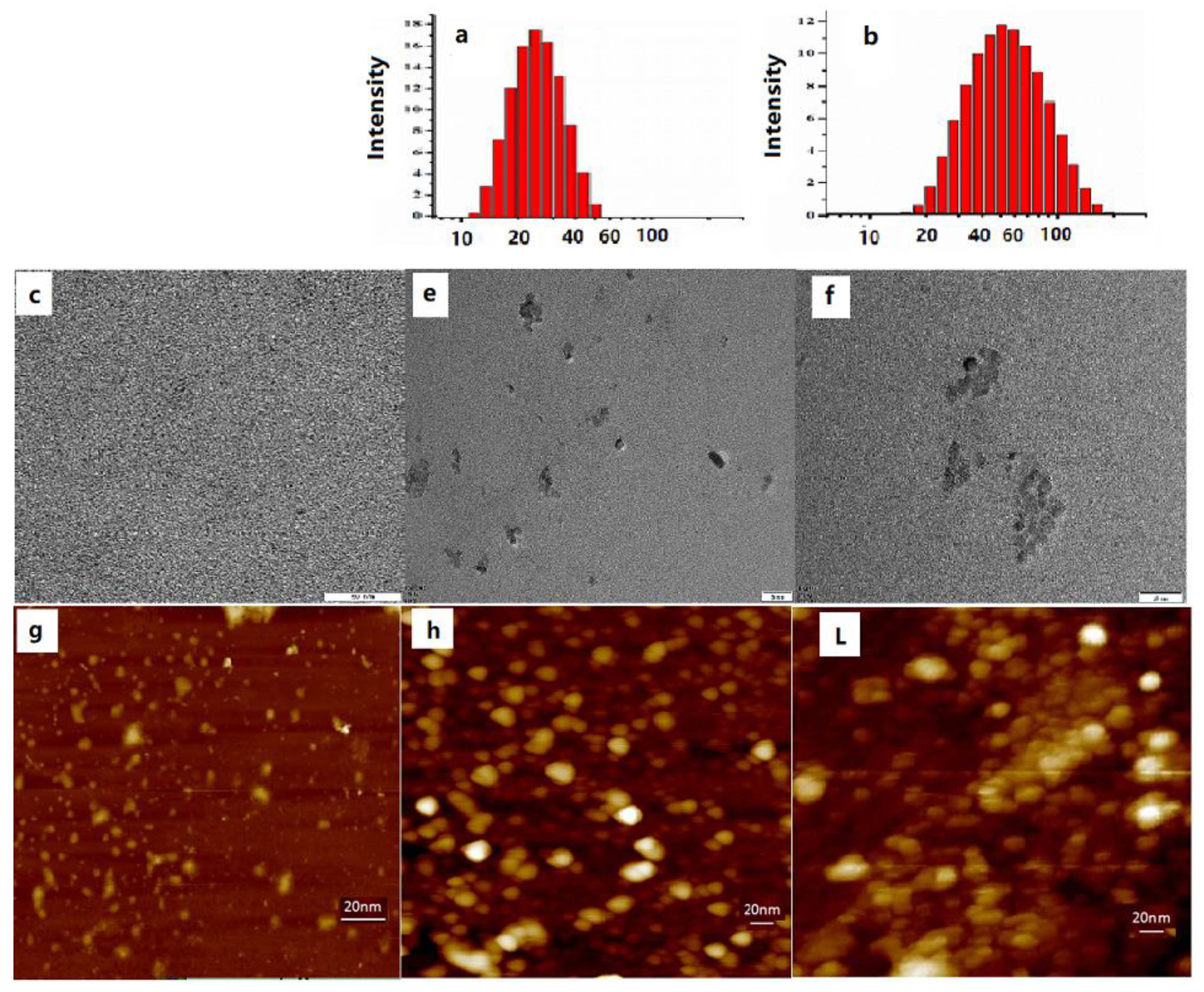
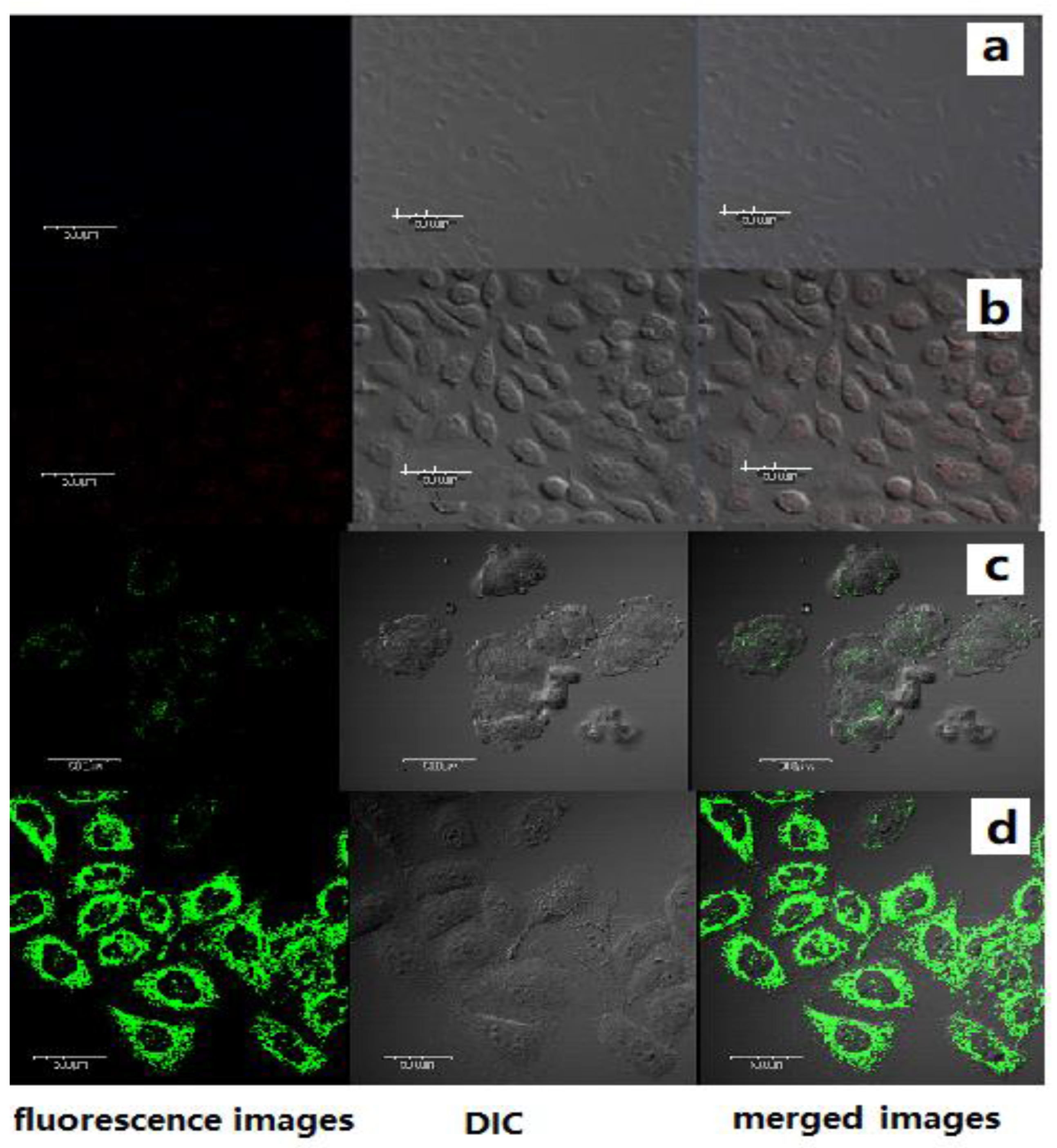
| Name | PCBMB | BAPTAVP | BAPTAVP-Ca2+ | PCBMB- BAPTAVP | PCBMB- BAPTAVP- Ca2+ | |
|---|---|---|---|---|---|---|
| Properties | ||||||
| λOPmax/λTPmax (nm) | 416 | 573/606 | 574/606 | 467/569 | 468/569 | |
| Φs [c] | 0.32 | 0.098 | 0.13 | 0.39 | 0.65 | |
| Φδ [d] (GM) | NF [e] | 16.2 | 23.2 | 89 | 169 | |
| ZPs [f] (mV) | −52.1 | 10.5 | 27.5 | 46.4 | −16.4 | |
© 2019 by the authors. Licensee MDPI, Basel, Switzerland. This article is an open access article distributed under the terms and conditions of the Creative Commons Attribution (CC BY) license (http://creativecommons.org/licenses/by/4.0/).
Share and Cite
Zhai, Y.-l.; Wang, Q.-b.; Yu, H.; Ji, X.-y.; Zhang, X. Enhanced Two-Photon Fluorescence and Fluorescence Imaging of Novel Probe for Calcium Ion by Self-Assembly with Conjugated Polymer. Polymers 2019, 11, 1643. https://doi.org/10.3390/polym11101643
Zhai Y-l, Wang Q-b, Yu H, Ji X-y, Zhang X. Enhanced Two-Photon Fluorescence and Fluorescence Imaging of Novel Probe for Calcium Ion by Self-Assembly with Conjugated Polymer. Polymers. 2019; 11(10):1643. https://doi.org/10.3390/polym11101643
Chicago/Turabian StyleZhai, Yue-liang, Qiu-bo Wang, Hao Yu, Xiao-yuan Ji, and Xian Zhang. 2019. "Enhanced Two-Photon Fluorescence and Fluorescence Imaging of Novel Probe for Calcium Ion by Self-Assembly with Conjugated Polymer" Polymers 11, no. 10: 1643. https://doi.org/10.3390/polym11101643
APA StyleZhai, Y.-l., Wang, Q.-b., Yu, H., Ji, X.-y., & Zhang, X. (2019). Enhanced Two-Photon Fluorescence and Fluorescence Imaging of Novel Probe for Calcium Ion by Self-Assembly with Conjugated Polymer. Polymers, 11(10), 1643. https://doi.org/10.3390/polym11101643




